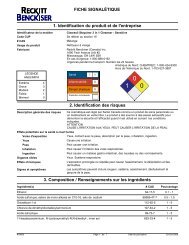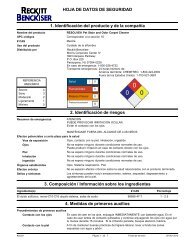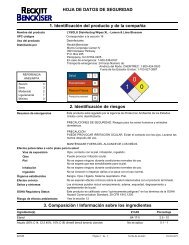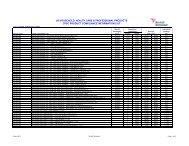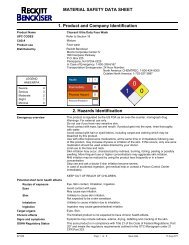Sustainability Report 2010.pdf - Reckitt Benckiser
Sustainability Report 2010.pdf - Reckitt Benckiser
Sustainability Report 2010.pdf - Reckitt Benckiser
Create successful ePaper yourself
Turn your PDF publications into a flip-book with our unique Google optimized e-Paper software.
Contents<br />
Introduction<br />
Environment<br />
Marketplace<br />
Workplace<br />
Community<br />
Managing & <strong>Report</strong>ing<br />
p11<br />
Waste<br />
We have reduced our total waste generation<br />
by 19% per unit of production since 2000<br />
but the total waste volume has increased<br />
by 11%.<br />
Our long-term strategy is to continually reduce<br />
waste generation and improve our recycling of<br />
waste arising from our operations, especially<br />
hazardous waste, which is more difficult to<br />
recycle and dispose of.<br />
We created 0.010 tonnes of waste for every<br />
1,000 CUs of production in 2010, of which<br />
8.6% or 0.001 tonnes per 1,000 CUs is<br />
hazardous and is disposed of in accordance<br />
with local legislative requirements.<br />
This was 11% per unit of production lower<br />
than in 2009 and hazardous waste was<br />
7% lower per unit of production. Our total<br />
waste in the year decreased by 2% and<br />
hazardous waste increased by 1%.<br />
For this year’s report, we have excluded all<br />
waste from our Johannesburg site from<br />
our data (2000 - 2010) due to data quality<br />
concerns. We hope to incorporate this data<br />
again in our 2011 <strong>Sustainability</strong> <strong>Report</strong>.<br />
Continual improvement of our waste<br />
Normalised total waste<br />
management since 2000 has reduced<br />
hazardous waste generation by 59% per unit<br />
of production, and 44% in actual volumes.<br />
However, new introductions sometimes<br />
offset progress with existing products.<br />
For example:<br />
• Better management and waste reduction<br />
schemes at Derby in the UK, have reduced<br />
hazardous waste by 55%.<br />
• At Chartres, France, the launch of new<br />
products in 2010, increased hazardous<br />
waste by 38% per unit of production.<br />
Normalised Hazardous waste<br />
Total Waste Recycled<br />
Normalised Total Waste<br />
Metric Tonnes per 000’ CUs<br />
0.015<br />
0.012<br />
0.009<br />
0.006<br />
0.003<br />
0.0<br />
0.0025<br />
0.0020<br />
0.0015<br />
0.0010<br />
0.0005<br />
0.0000<br />
80<br />
60<br />
40<br />
0.0129<br />
00<br />
Normalised Hazardous Waste<br />
Metric Tonnes per 000’ CUs<br />
0.0022<br />
00<br />
Total Waste Recycled*<br />
Including Hazardous Waste<br />
60.8%<br />
0.0116<br />
09<br />
0.0010<br />
09<br />
73.4%<br />
0.0104<br />
10<br />
0.0009<br />
10<br />
76.1%<br />
Vanish pouch saves carbon<br />
In Thailand, we changed the<br />
packaging of Vanish powder from<br />
a tub to a pouch. This small change<br />
has saved over 23,000 tonnes of<br />
CO 2 e per year.<br />
20<br />
0.0<br />
01<br />
09<br />
10<br />
* This data is not included in PwC’s assurance<br />
of our <strong>Sustainability</strong> data<br />
RB <strong>Sustainability</strong> <strong>Report</strong> 2010 11



